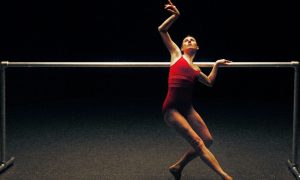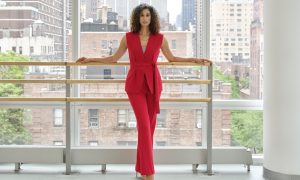The Foundry, Cambridge, MA.
April 30, 2023.
The arts are an ecosystem; the thriving (or lack thereof) of artists in community – at various levels of experience and creative output – are interconnected. The degree to which audience members from all walks of life feel welcome, and furthermore engaged, also impacts the health of this ecosystem.
As a critic, I’ve seen work from all parts of the ecosystem, all sorts of patrons with me in the audience — from humble small town dance companies to “top dogs” such as Alvin Ailey American Dance Theater and New York City Ballet. At all of these ecosystem levels, I’ve seen work that I’ve found successful and less successful.
Alive Dance Collective’s Ink in Motion underscored for me what’s most important, at whatever part of the ecosystem one resides — committing to an intentional vision, giving one’s absolute all, and creating a space where anyone and everyone can feel welcome to come experience the art at hand. The program as a whole offered those essential elements in spades upon spades.
Appropriately enough, the venue – Cambridge’s The Foundry – oozes with that spirit of welcoming all to make and to enjoy art. There’s a feeling in the air of excitement about reaching for creative excellence, with curiosity, passion and community care.
Quite fitting for that inviting spirit, Alive Dance Collective Artistic Director Brenna Banister introduced the show with an air of humor, joy and invitation for all to simply experience. The paper program included space for coloring as well as a word search. A short participatory movement session followed the program, to boot.
In addition to the works described in more depth below, the program also included: karen Krolak and Nicole Harris’ _____[207], an abstruse work with key potential to provoke thought and challenge audience members; Audrey Hatas’ Choose Your Own Adventure, a kinetically dynamic work investigating ample possibility; and Caroline Bradbury and Claire Lane’s Malefica, an intriguing work of clear aesthetic and deep meaning in the experience of femininity, both shared and so very individual to each living it.
Banister’s SuperFoods opened the program, a delightful mish-mash of animated characterization and rigorous contemporary dance. Dancers wore all black, yet their movement was anything but dark in tone and uniform; fully vibrant and in clean unison, it resembled a flash mob – the kind I’d definitely, if I saw it happening in the street, feel out if I could jump right into.
Gestures reminiscing capes flying back made it feel like super(s!)heros had flown in, and more crisply robotic movement reflected video game characters. At the same time, the ensemble offered the melty spinal release and unhindered flow of momentum characteristic of contemporary dance (and which can make it so delicious to experience – dancing or watching).
As a theme and tone present in much of the program to come, the work reminded me that childlike play and wonder can very much walk hand-in-hand with what we might consider more “serious” things. In fact, that can be a combination that we might all do well to explore more.
Speaking of tone, there was certainly a shift in atmosphere with the second work: Alexandria Nunweiler’s All the Advice I Could Not Take, a solo commendably danced by Diana Pilarski. More reflective and understated than the show opener, the work was a tenacious exploration of various kinds of virtuosities and fluid meanings. The score (from Roy Sōderland and Philip Glass) also brought something bittersweet to the air, supporting the honest investigation of an emotional spectrum.
Nunweiler took her time to build athleticism, therein opening space for a virtuosity of presence and physical integration rather than giant leaps or impossibly layered movement phrases. Tender movement led into more weighted and thrusting vocabulary – which Pilarski supported with full (and wonderfully audible) breath. Nunweiler’s movement vocabulary was most satisfying when it felt most uniquely hers. All in all, the work boldly dared to investigate a wide variety of ways to be, to feel, and to move in space.
Lila Klaus’s Perpetually kept up that bold spirit, with keen movement vocabulary and structure speaking volumes about the way three people can relate: in space, in support, in energy. Spoken word in the score (from Graham Peck) spoke to moving together and “melting” into each other. In unison and non-unison, with dancers together and apart in space, the trio brought these ideas to supple tangible life.
As a dynamic opposite, movement vocabulary in certain sections conveyed that timeless tension of wanting to reach out but also to remain internal. Sharing each other’s weight reflected surrender to giving and to taking support, of connection without walls. From those moments of support, dancers moved out in space with an increased sense of strength and assurance – a beautiful metaphor in aqueous movement. Both Klaus and the ensemble’s contributions felt fresh and fully aligned with them as unique artists – perhaps a big part of how these ideas came to vivacious life in the space before us.
Ramfeezled (Still) came later, restaged by Krolak, Harris and Banister. The work was a charming highlight of just how sharply, intelligently funny dance can be. Bannister, as a central character, animated advice from beauty magazines on how to attract a mate, how to truly “wow” them on that special date.
Through clever and sometimes effectively hyperbolic characterization, she demonstrated the absurdity in many of these narratives. Guided by voiceover sharing this date advice, she stuck out her elbows and then pinned them sharply back in, did the “pony” and then stood up tall and straight – motionless but eyes searching. Many audience members laughed heartily, myself certainly included.
The ending brilliantly underscored the larger meaning at hand. The last voiceover guidance was to “above all, just be yourself” (to which one might very understandably respond, along with all of those other things that I’m supposed to do…huh? …how?). Then, with Banister sprawled out in exhaustion from trying to follow all of these tips, came in someone saying, “Hi, are you Brenna?” I’ll just let the cleverness of all that sink in.
Second-to-last in the program came February 14, 1999, choreographed and performed by Katrina Conte. The work is a touching illustration of finding true love — that person who loves you for you, and having that person with you no matter what else life may bring. Voiceover was quite specific about context – the middle of the night before a wedding day.
Conte began to move along with this auditory context, offering fluid circularity but also expansive lines, clarity of shape but also snakey mysteriousness. Her persona danced out the self-doubt that the voiceover described: questioning where she has gotten in life and what it’s all for. Frenetic shifts in direction and shape embodied this poignant uncertainty.
Then, she came to affirm that no matter what that might be, she’s found her “person”. That would remain a special something, come what may. Conte’s movement took on greater ease and integration, both firm foundation and energetic lift – making viscerally tangible that shift into affirmation. As with Perpetually, intentionality and commitment in both choreography and performance allowed this depth of meaning to translate.
The simultaneously sweet and humorous, apt and well-crafted 💚🥚🐷 closed out the show. Banister had explained in her program introduction that Dr. Seuss’ Green Eggs and Ham only contains 50 words, assembled in varied syntax. For this work, Conte assigned movements to those words – and then, just as Dr. Seuss did in writing, assembled them into movement phrases, sentences and sections.
Just as with much of the choreography in the program, athletic movement vocabulary came seamlessly together with characterization — gesture, facial expression and specific presence. So much was beautifully carefree and childlike, yet – as with the best children’s programming, in this writer’s humble opinion – had more mature elements as well. That offered something for anyone, at any age, to enjoy.
With respect to younger viewers, repeated phrases and movements reminisced the repetition and rhyming in children’s books — tools that facilitate literacy building. In further iterations of the work, to that spirit of accessibility to all ages and attention spans, I might encourage dissecting the work for ways in which it can be edited and shortened; as much as I heartily enjoyed it, I could imagine it starting to feel long and drawn-out for some audience members. On the whole, however, this work – as with the larger program – invited all audience members into something with the potential to delight, intrigue and even provoke deep thought.
As the program concluded, I reflected on how all of that was possible because of these artists’ commitment to intentional craft, and the supports allowing them to realize that devotion – no matter what part of the arts ecosystem they occupy. Each level matters, each artist matters. A memorable reminder of that, an afternoon of engaging art, and much more — Alive Dance Collective’s Ink in Motion offered all of that and more. I’m grateful to have experienced it!
By Kathryn Boland of Dance Informa.















